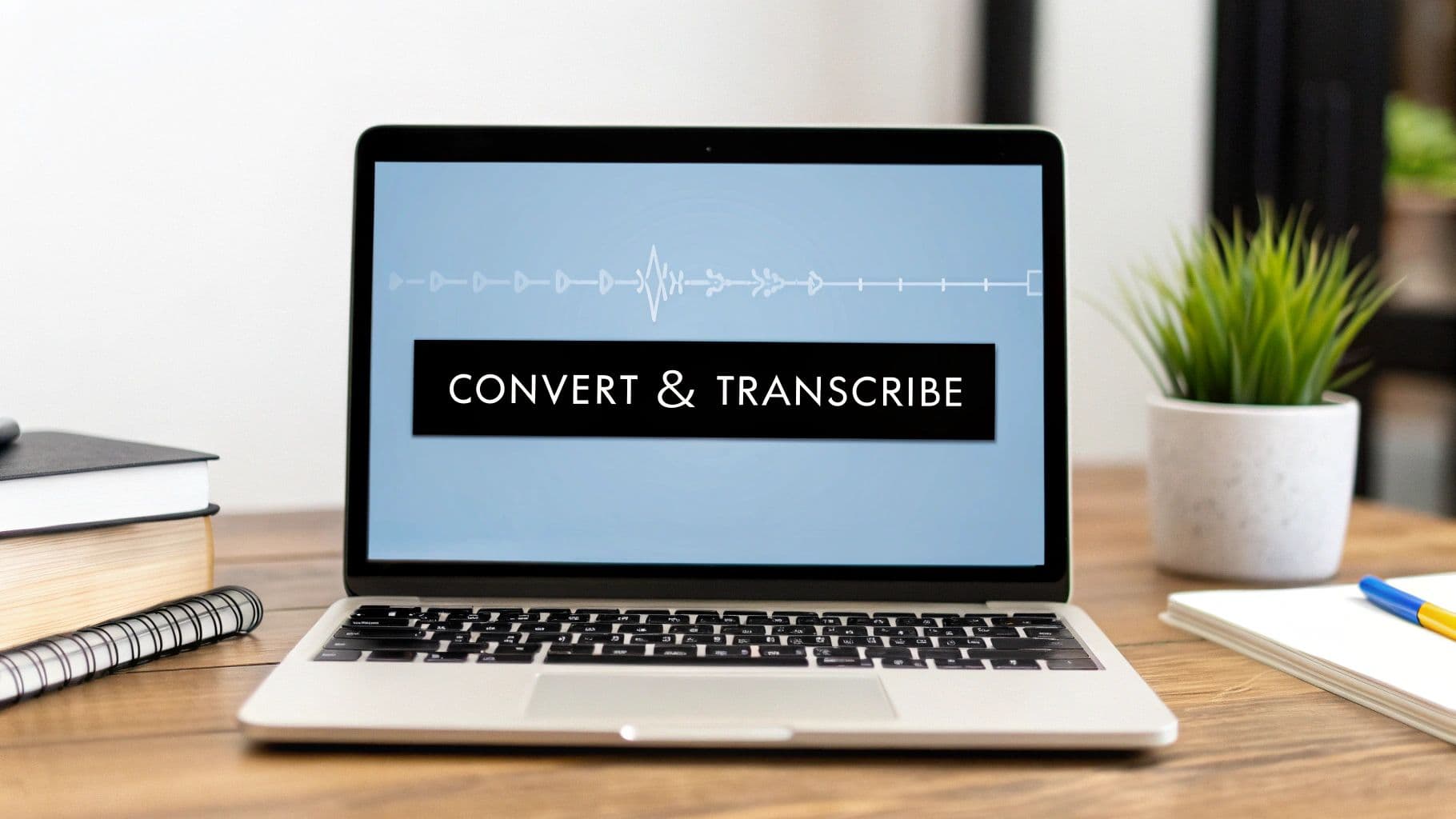Grabbing the audio from a YouTube video is surprisingly simple. If you've ever needed to youtube to mp3 convert, you know the drill: find a good online tool, copy the video's URL, paste it in, and download the MP3. The whole thing usually takes less than a minute.
But why do so many people perform this popular search? It’s more than just a trending keyword; it’s a gateway to making content truly portable and useful in a whole new way.
From Video Stream to Your Pocket
Let's be honest, a lot of the time, it’s about music. People want to build playlists for their commute, the gym, or for trips where Wi-Fi is sketchy at best. Instead of being glued to a video stream, they can have their favorite tracks ready to go, anytime, anywhere.
Beyond just tunes, the reasons to convert YouTube videos to MP3 get a lot more strategic.
Turning Spoken Words into a Superpower
Think about who else benefits from pulling just the audio from a video:
- Students & Researchers: They’re converting entire lectures, detailed interviews, and educational webinars into audio files. This lets them listen back to dense material while they're driving, walking the dog, or doing chores. It's a classic study hack.
- Content Creators: Podcasters and video editors are constantly sourcing soundbites, background music, or unique sound effects from YouTube. A reliable youtube to mp3 convert process is a vital first step to mix those clips into their own work.
- Professionals: That keynote speech from an industry conference? Or that panel discussion with market leaders? Professionals save these as audio to catch up on insights during their drive, turning dead time into professional development.
The scale of this is just massive. Since the mid-2000s, YouTube has ballooned into the world's biggest video library, with over 2.7 billion monthly active users. With nearly everyone on the internet watching online videos, the demand for audio is staggering, easily leading to billions of conversions every single year.
Here's the key takeaway: converting the video is just step one. The real magic happens when you take that audio file and run it through a transcription service. That's when spoken words become searchable, editable, and infinitely more useful text.
This is exactly where a tool like MeowTxt, an audio-to-text transcription service, comes into play. By feeding it your converted MP3, you can get back a full transcript in minutes. From there, it's easy to pull direct quotes, create detailed study notes, or even spin an entire blog post from a single video, completing the content cycle.
Picking the Right MP3 Quality for Your Needs
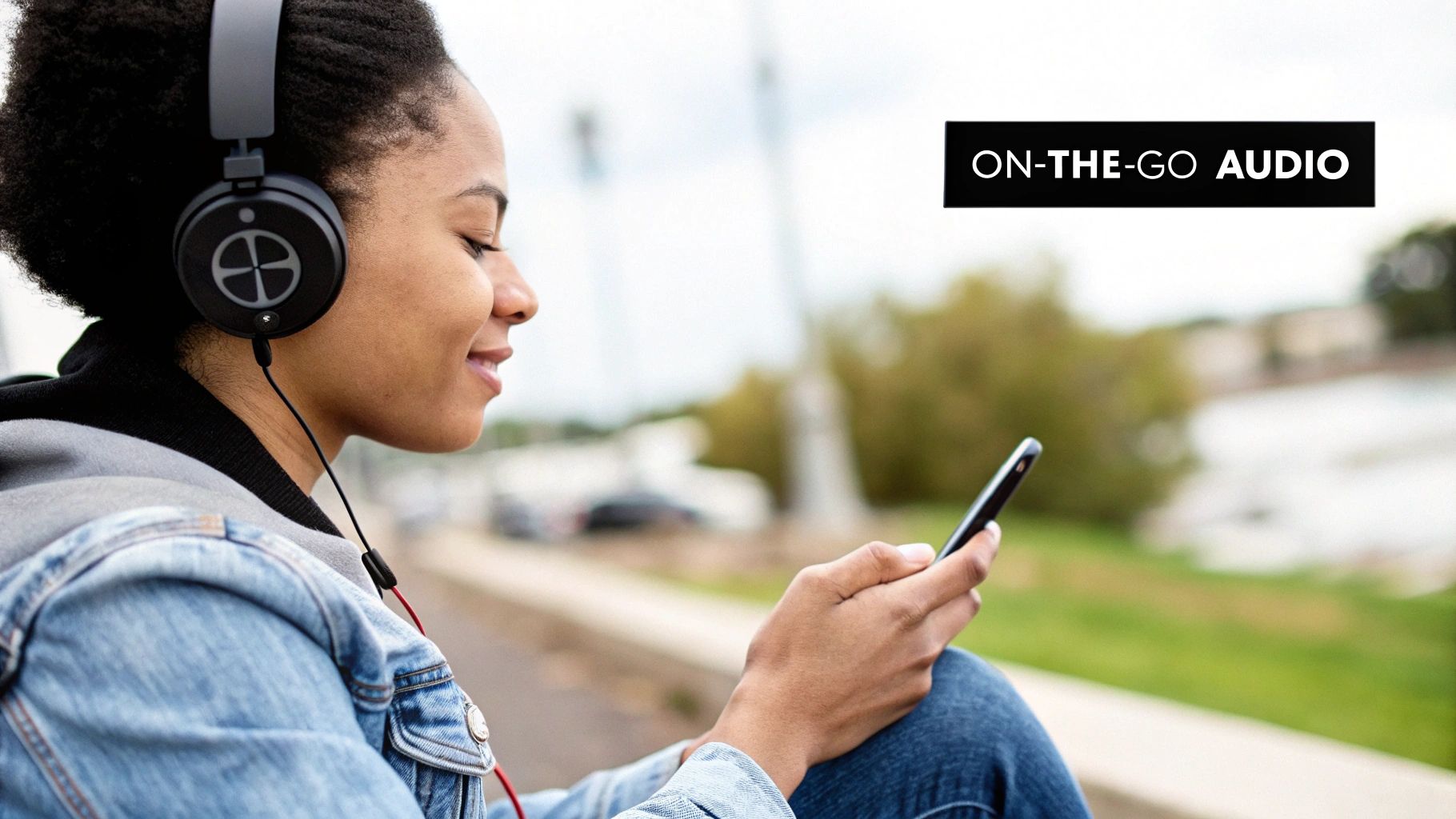
When you decide to convert a YouTube video to MP3, you'll quickly run into a couple of key choices that shape the final result. The path you take affects everything from the audio's clarity and file size to your own device's security.
The first big decision is whether to use a web-based tool or a piece of desktop software. I get it—online converters are super convenient. There's nothing to install, and you can have your MP3 in just a few clicks. The downside? Many of these sites are a minefield of aggressive ads, annoying pop-ups, and even potential malware if you land on a shady one.
Desktop apps, on the other hand, often give you more control, like batch downloads and higher-quality audio options. But they require installation and sometimes come with a price tag. For most one-off jobs, a trustworthy online tool like https://www.meowtxt.com/convert/yt-to-mp3 is usually the perfect middle ground.
So, What's the Deal with Bitrate?
The single most important setting you’ll see is the bitrate, measured in kilobits per second (kbps). Think of it as the audio's resolution. A higher bitrate means more data is used to represent the sound, giving you a richer, fuller audio experience—but also a larger file.
Listener expectations have really shot up. Back in the day, 128kbps was the standard. Now, for the over 60% of downloads that are music, people want 256kbps or even 320kbps for that crisp, CD-like quality. You can see how these habits have evolved in these findings on MP3 quality trends.
The right bitrate really just comes down to what you're using the audio for.
Choosing Your MP3 Bitrate for Quality and Purpose
Use this table to decide on the best audio quality for your needs, balancing sound clarity against file size.
| Bitrate | Audio Quality | Typical File Size (4-min audio) | Best Use Case |
|---|---|---|---|
| 320 kbps | Excellent (Near CD) | ~9.2 MB | Music, podcasts, or any audio where clarity is critical. |
| 256 kbps | High Quality | ~7.3 MB | A great all-rounder for music and spoken word content. |
| 128 kbps | Good (Standard) | ~3.7 MB | Perfect for lectures or interviews intended for transcription. |
For a task like transcribing a lecture or meeting, a smaller 128kbps file works great. It's more than clear enough for transcription software and saves a ton of space and upload time.
This makes it perfect for a service like MeowTxt's YouTube to MP3 tool, where you can quickly turn that audio into a clean, accurate text document.
How to Convert YouTube Videos to MP3 Safely
Let’s get practical. Say you just watched a brilliant industry talk on YouTube and you want the audio for your commute or your notes. How do you actually youtube to mp3 convert that file without wading through pop-up ads and sketchy download buttons?
It all starts with grabbing the video's URL. Just head to the YouTube video, click the 'Share' button right below the player, and hit 'Copy'. That link is your golden ticket.
Finding and Using a Safe Converter
This is where most people get tripped up. A quick search for a converter will throw a ton of options at you, but many are designed to be confusing, often hiding the real download button behind layers of ads.
You're looking for a clean, purpose-built tool. A great example is a dedicated page like the one MeowTxt offers for YouTube to MP3 conversion. These specialized services are built for one job, which means less clutter and a much safer experience.
Once you’re on the site, just paste your YouTube link into the box. You'll usually get an option for audio quality. For spoken content like a webinar or lecture, 128kbps is the sweet spot—it gives you crystal-clear audio without creating a massive file.
The whole process should feel this simple:
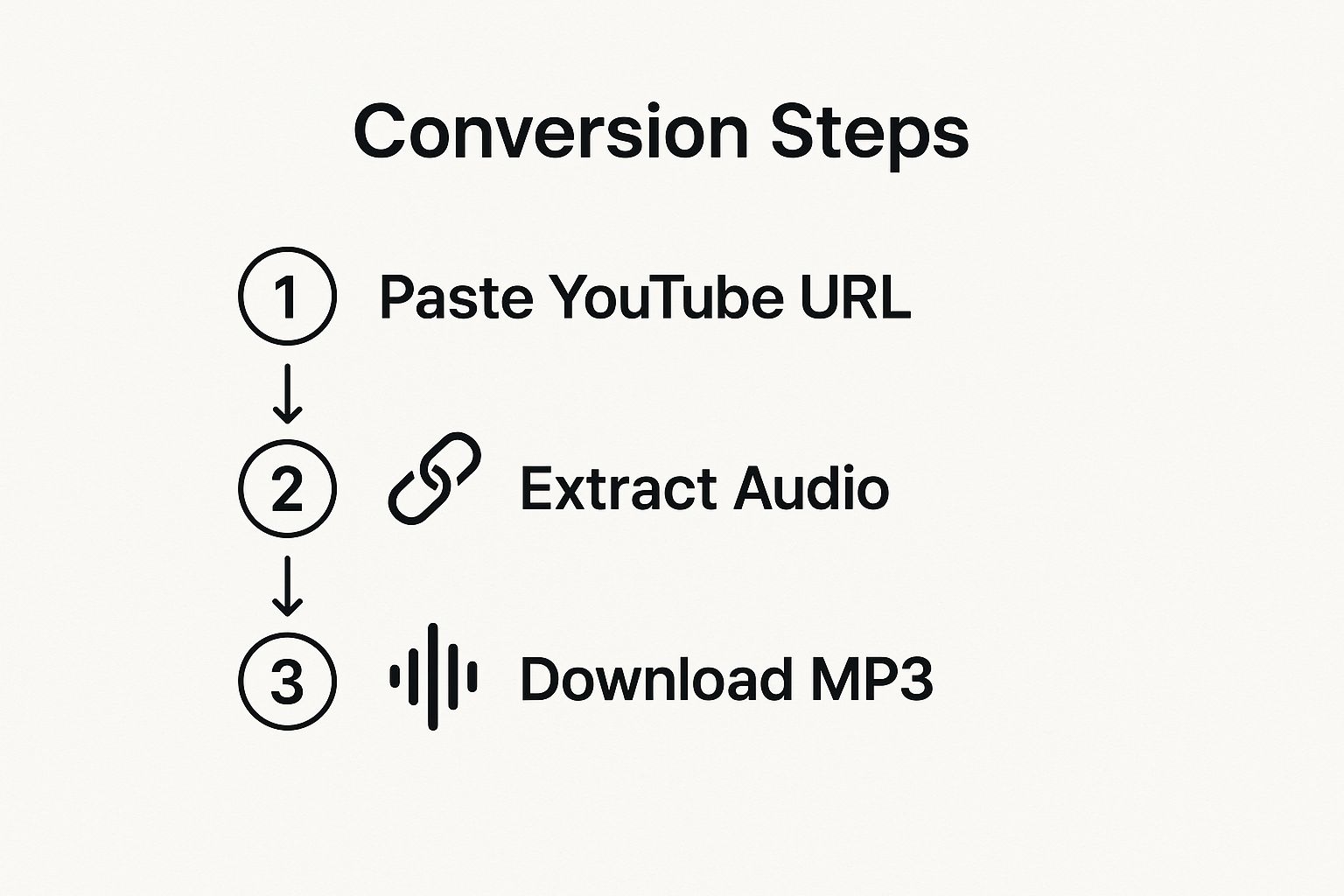
If the service you're using feels more complicated than that, it's a red flag. A trustworthy youtube to mp3 convert tool should be straightforward.
A quick note on privacy: any time you use an online tool, you should know what’s happening with your data. Reputable services are transparent about this. You can usually find a privacy policy, and you can see what to look for in our own guide on data and privacy protection.
After you've pasted the link and picked your quality, just click 'Convert' or 'Download'. The tool handles the rest, stripping the audio from the video and giving you a clean MP3 file to save directly to your computer or phone.
Turn Your Audio into Text with Free Transcription
Alright, you’ve pulled it off. You used a youtube to mp3 convert tool and now have a crisp audio file ready to go. So, what's next? This is where the magic really happens: turning all that spoken audio into text you can actually use—text you can search, edit, and share.
Gone are the days of painstakingly typing out audio word-for-word. With the right tools, this process is now practically instant.
Think about it. A two-hour podcast becomes a document you can scan for keywords in seconds. For students, this is a game-changer, transforming a long lecture into study notes without touching the keyboard. Marketers can snag key quotes from a webinar for social media, and researchers can analyze interview data with incredible speed.
Unlocking Your Audio with a Free Tool
Getting this done is surprisingly simple. A good service makes the whole workflow seamless, letting you jump straight from an MP3 to a complete text document.
You can see just how clean the interface is on the MeowTxt YouTube to MP3 converter and transcriber. It's built for one thing: getting your audio uploaded and analyzed, fast.
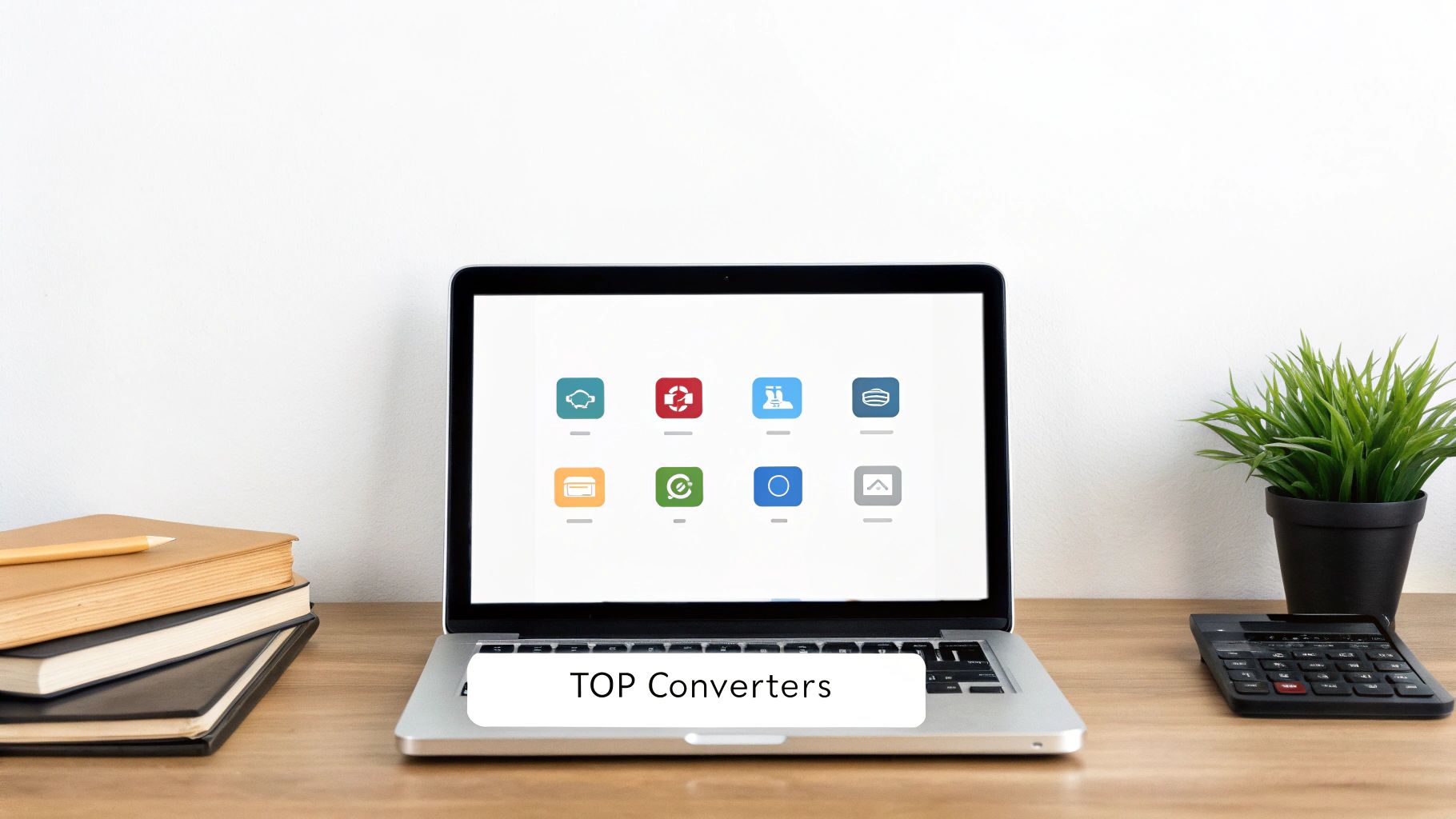
The simple drag-and-drop feature means you’re just a few clicks away from having a full transcript. It’s the perfect bridge between just listening to information and actually working with it.
Once you have an accurate transcript, a whole new world of possibilities opens up. You can pinpoint specific information, create summaries on the fly, or repurpose the content for completely different formats.
The real power here is turning passive audio into an active asset. An MP3 is for listening, but a transcript is for doing. It becomes the foundation for articles, reports, and deep-dive analysis.
After getting your text, you might even want to take it a step further. Learning about modifying transcripts and regenerating voice can open up even more creative avenues for adapting your content for entirely new projects.
Building a Smart and Efficient Workflow
Going beyond a one-off conversion means building a repeatable process you can trust. A solid workflow does more than just save time—it's your best defense against the sketchy side of youtube to mp3 convert tools, keeping you safe from malware and saving you from a chaotic downloads folder.
First things first: you have to learn to spot and dodge the shady websites. I've seen them all—sites plagued with pop-up ads, fake "download" buttons designed to trick you, and sketchy requests to install browser extensions. A trustworthy converter, like the one built right into MeowTxt's platform, is clean and focuses on one thing: getting your file. Sticking to reputable services is non-negotiable.
Organize Your Audio Files Like a Pro
Once you've grabbed your MP3, organization is everything. Trust me, a messy downloads folder becomes a black hole surprisingly fast. The trick is to adopt a consistent naming convention so your audio library is always clean and searchable.
Here are a few naming systems I use that work wonders:
- For Podcasts:
PodcastName_EpisodeNumber_Date.mp3 - For Lectures:
CourseName_LectureTitle_Date.mp3 - For Interviews:
IntervieweeName_Project_Date.mp3
It’s a simple habit, but it makes finding a specific file weeks later completely effortless. I recommend storing them in dedicated folders, sorted by project or topic.
The real goal here is to create a safe, repeatable process. This lets you focus your energy on what you’ll do with your content, not just on managing files. A good workflow makes your audio assets easy to find and ready for the next step, whether that's transcription or sharing.
To really get the most value out of your audio, you'll want to explore some smart content repurposing strategies. Turning a single audio file into blog posts, social media snippets, and email newsletters is a total game-changer for expanding your reach. You can learn a lot more about building these kinds of efficient systems over on the MeowTxt blog.
Common Questions About Conversion and Transcription
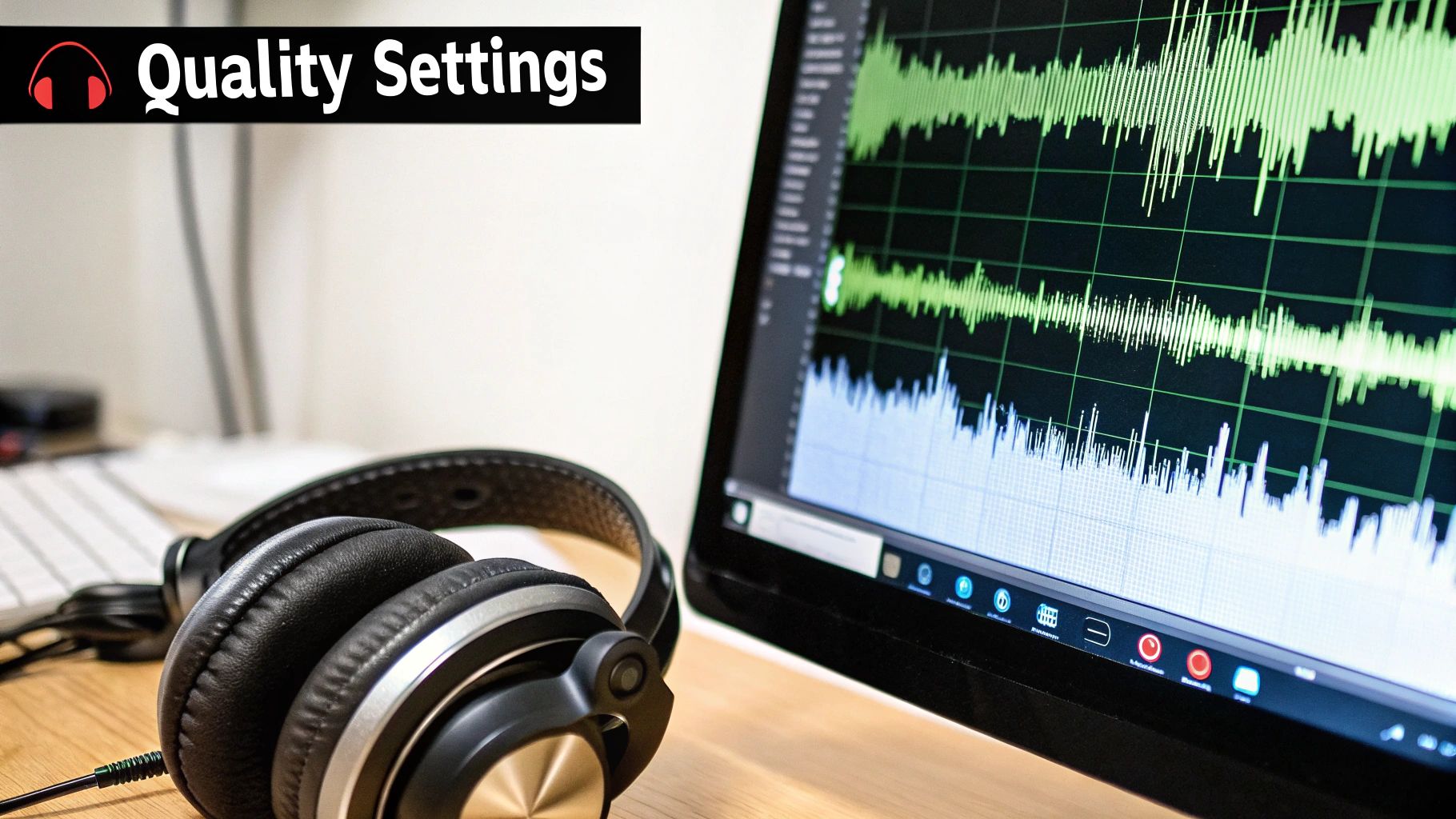
Even with a simple process, a few key questions always pop up. When you start pulling audio from videos and turning it into text, you naturally wonder about the legal side of things, not to mention quality and accuracy.
Let's clear the air. Getting solid answers to these common questions will help you use any youtube to mp3 convert tool confidently, so you can get the text you need while staying on the right side of content creators.
Is It Legal to Convert YouTube Videos to MP3?
This is the big one, and frankly, it's a bit of a gray area. The legality really boils down to the video's copyright status and your local laws. It's almost always okay to convert content that’s in the public domain or if you have direct permission from the creator.
Things get murkier with copyrighted material. Using it for personal, non-commercial purposes often falls under "fair use" or "private copying" rules in some countries.
The absolute red line is distribution. Never, ever share or try to monetize copyrighted audio you've downloaded. That’s a clear-cut legal no-go. Always respect creator rights and YouTube's terms of service.
Does Converting to MP3 Reduce Audio Quality?
Yes, a little bit of quality loss is inevitable. It's just the nature of digital audio compression. YouTube already compresses audio to make it streamable, and when you youtube to mp3 convert it, you're essentially compressing an already compressed file.
But you can keep this loss to a minimum. When you convert, always aim for a high bitrate like 256kbps or even 320kbps. For most people listening on normal headphones or speakers, the difference between that and the original YouTube audio will be practically impossible to hear.
How Accurate Is AI Transcription from an MP3?
The accuracy of any AI transcription tool is almost entirely dependent on the quality of your MP3. It’s a classic "garbage in, garbage out" scenario.
If you feed it a clean recording with a single, clear speaker and no background noise, a tool like the one at MeowTxt's converter and transcriber can deliver shockingly accurate results.
But if your audio is full of background music, people talking over each other, or heavy accents, the accuracy will naturally drop. For the best transcription, always start with the highest-quality YouTube video you can find and convert it to a high-bitrate MP3. It makes all the difference.
